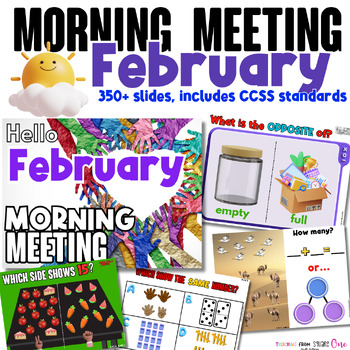Morning Meeting, Morning Work, Kindergarten Morning meeting, February calendar
- Zip
Description
Elevate your Kindergarten Morning Meetings with this comprehensive year-round digital bundle, combining Morning Meeting Slides.
This is perfect for fostering a sense of community and effective classroom management in your kindergarten setting.
Morning Meeting slides are user-friendly, digitized resource that encompasses animated Powerpoint and Google Slides deck for the 4 weeks of February or 20 days worth of Morning Circle slides, ensuring a seamless start to your morning routine.
The weekly slide templates kick off with a welcoming screen to showcase the Month, setting a positive tone for the day. Followed by a Morning Song-- a delightful signal for the start of your daily gathering.
The Greeting and Group Activity Templates offers fun greetings and activities. Students actively participate in a variety of rotating daily activities, sharing their thoughts and opinions to strengthen their speaking and listening skills.
At the heart of these slides lies Today's Message slide, Calendar, Math, & Literacy Activities, and Think and Share sections. Here, you can seamlessly integrate your calendar routine and morning messages.
This will be part of a Bundle! Each month introduces new and engaging skills.
February Skills:
ELA
- RF.K.2.c -Blend and segment onsets and rimes of single-syllable spoken words.
- RF.K.2.D - Vowel practice
- RF.K.2.e - Add or substitute individual sounds (phonemes) in simple words
- RF.K.3.b - Associate the long and short sounds with common spellings
- L.K.2.C - consonant letter blends
- RL.K.1 - With prompting and support, ask and answer questions
- L.K.5.b - antonyms
- L.K.5.d - Distinguish shades of meaning
Math
- K.NBT.1 - Compose and decompose numbers from 11 to 19 into ten ones and some further ones, e.g., by using objects or drawings, and record each composition or decomposition by a drawing or equation
- K.CC.5 - Count to answer "how many?" questions about as many as 20 things arranged in a line, a rectangular array, or a circle, or as many as 10 things in a scattered configuration; given a number from 1-20, count out that many objects.
Don't forget to leave feedback! :) TPT offers credits that can be applied to future purchases! To earn credit, simply rate and comment on the product.
Follow my TPT store to get notified of new products! I often offer 50% off for the first 48 hours - Follow Me Here
You can also follow me on social media --> @teachingfromsquareone
This product is for personal use in a single classroom only. No part of this download may be copied, sold, distributed, or edited without the permission of the author. Additional licenses may be purchased from my TPT store. Please do not post this document online; however, feel free to blog or post on social media about the use of this product as long as you credit it back to my TPT store with a link.
Camille from Teaching from Square One





